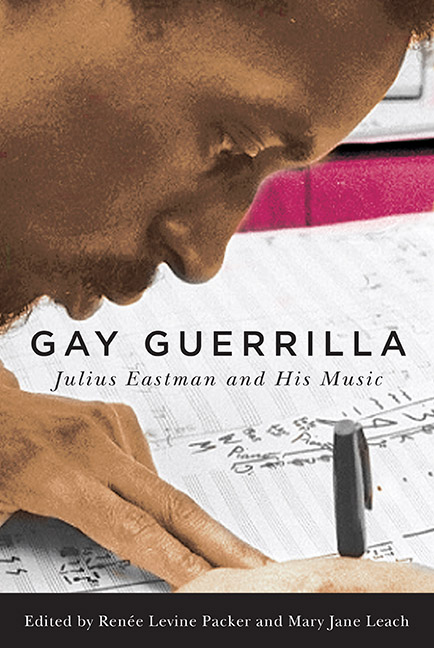Book contents
- Frontmatter
- Contents
- Foreword
- Acknowledgments
- Introduction: Julius Eastman and His Music
- 1 Julius Eastman, A Biography
- 2 Unjust Malaise
- 3 The Julius Eastman Parables
- 4 Julius Eastman and the Conception of “Organic Music”
- 5 Julius Eastman Singing
- 6 An Accidental Musicologist Passes the Torch
- 7 A Flexible Musical Identity: Julius Eastman in New York City, 1976–90
- 8 Evil Nigger: A Piece for Multiple Instruments of the Same Type by Julius Eastman (1979), with Performance Instructions by Joseph Kubera
- 9 A Postminimalist Analysis of Julius Eastman’s Crazy Nigger
- 10 “That Piece Does Not Exist without Julius”: Still Staying on Stay On It
- 11 Connecting the Dots
- 12 Gay Guerrilla: A Minimalist Choralphantasie
- Appendix: Julius Eastman Compositions
- Chronology
- Selected Bibliography
- List of Contributors
- Index
- Eastman Studies in Music
7 - A Flexible Musical Identity: Julius Eastman in New York City, 1976–90
Published online by Cambridge University Press: 26 May 2021
- Frontmatter
- Contents
- Foreword
- Acknowledgments
- Introduction: Julius Eastman and His Music
- 1 Julius Eastman, A Biography
- 2 Unjust Malaise
- 3 The Julius Eastman Parables
- 4 Julius Eastman and the Conception of “Organic Music”
- 5 Julius Eastman Singing
- 6 An Accidental Musicologist Passes the Torch
- 7 A Flexible Musical Identity: Julius Eastman in New York City, 1976–90
- 8 Evil Nigger: A Piece for Multiple Instruments of the Same Type by Julius Eastman (1979), with Performance Instructions by Joseph Kubera
- 9 A Postminimalist Analysis of Julius Eastman’s Crazy Nigger
- 10 “That Piece Does Not Exist without Julius”: Still Staying on Stay On It
- 11 Connecting the Dots
- 12 Gay Guerrilla: A Minimalist Choralphantasie
- Appendix: Julius Eastman Compositions
- Chronology
- Selected Bibliography
- List of Contributors
- Index
- Eastman Studies in Music
Summary
In a press release announcing a performance at The Kitchen in 1981, Julius Eastman provided a succinct autobiography:
I have sung, played, and written music for a very long time, and the end is not in sight. I sang as a boy soprano and I still sing as a boy soprano 30 years later. I have played the old masters on the pianoforte and have appreciated their help and guidance. But now music is only one of my attributes. I could be a Dancer, Choreographer, Painter or any other kind of artist if I so wished; but right thought, speech and action are now my main concerns. No other thing is as important or as useful. Right thought, Right Speech, Right action, Right music.
Eastman's self-assessment evinces a broad engagement with creative and expressive culture as he practiced it up to that point in his life. Eastman's autobiography speaks to a widely distributed and multiply directed aesthetic practice, one that explored networks of thought, speech, and action cutting across genres, styles, and communities. Nowhere is this more evident than in Eastman's time in New York's downtown scene in the years 1976–90.
Two examples from his performing repertoire in the 1970s demonstrate this plurality. Eastman had, in the early 1970s, become the chief performer of Peter Maxwell Davies's theater piece Eight Songs for a Mad King, through performances with the Creative Associates and his recording with Maxwell Davies's ensemble the Fires of London. This piece remained Eastman's claim to fame throughout the 1970s, and he sang it with other ensembles, including the Brooklyn Philharmonia under the direction of Lukas Foss, and the New York Philharmonic under Pierre Boulez. Yet at the same time, Eastman could also be heard singing avant-garde disco at The Kitchen. His recording with the group Dinosaur L, a loose dance music collective organized by composer-performer-producer Arthur Russell, extended the reach of Eastman's voice beyond high culture institutions to downtown's mostly gay dance clubs. Within Dinosaur L, Eastman's keyboard work was a powerful force, holding down the groove, as well as inflecting the songs with out-there improvisations on record.
- Type
- Chapter
- Information
- Gay GuerrillaJulius Eastman and His Music, pp. 116 - 130Publisher: Boydell & BrewerPrint publication year: 2015
- 1
- Cited by



